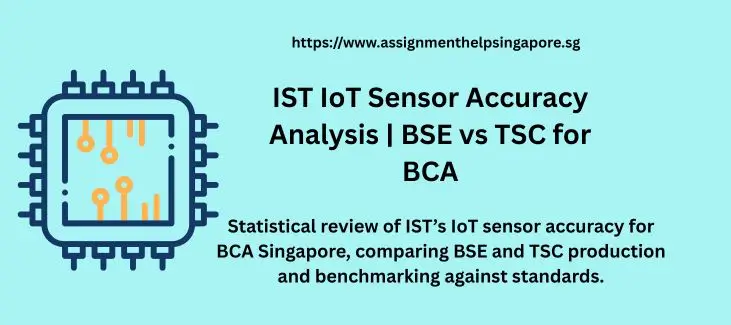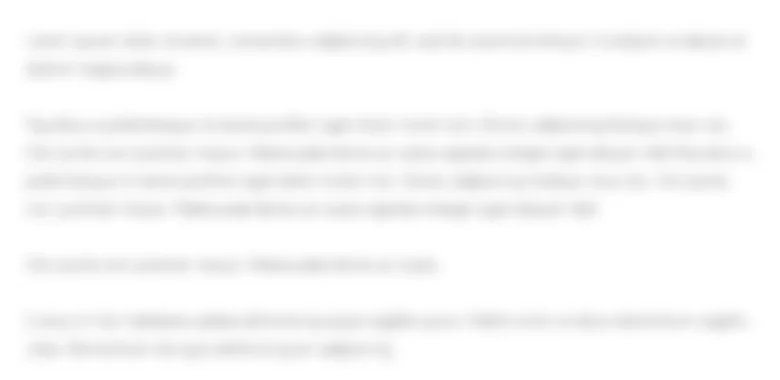
IST IoT Sensor Accuracy Analysis | BSE vs TSC for BCA
The Building and Construction Authority (BCA) in Singapore has decided to adopt a new air temperature Internet of Things (IoT)-enabled sensor. The sensor is designed to accurately measure air temperature from the air conditioning and mechanical ventilation (ACMV) system, a system that manages the airflow rate and cooling setpoint temperature specified by the building’s facility management. The data collected by the sensor can be used to accurately determine how much building energy is consumed.
Internet Sensing Technologies (IST) Ltd. manufactures and distributes a widely recognised brand of IoT-enabled sensors, intending to supply their sensors to the BCA for the ACMV system. To promote designs that advocate competency and reduce operation costs, IST outsources its manufacturing production to two contractors: Building Sensing Enterprise (BSE) and Total Sensing Corporation (TSC). Although TSC claims that BSE does not outperform its manufacturing process, IST has outsourced production to both contractors.
IST has designed an IoT-enabled sensor from the specifications based on a standard industrial model with known population parameters, which describe the sensors’ accuracy in terms of temperature: mean = 2.73oC and standard deviation = 0.73oC. IST’s management wishes to compare the accuracy of their IoT-enabled sensor to the industry standard model while verifying that TSC’s claim (i.e., BSE does not outperform them) is correct.
Assuming that you are a data analyst in IST’s Data Acquisition and Operations Department, the CEO of IST has requested you conduct a thorough analysis of the data measuring the IoT- enabled sensors’ performance produced by BSE and TSC. IST purchased an equal number of
25 sampled temperature measurements from sensors produced by BSE and TSC. The measurements are enclosed in the spreadsheet: “Sensor Accuracy” Excel file. This includes the “Measurement no.” (i.e., the order in which measurements were collected by each contractor), “Contractor” (TSC or BSE) and the “Sensor Accuracy” readings in oC. For the IoT-enabled sensors to be considered reliable, the temperature measurements must be as close as possible, or ideally the same, to the actual temperature controlled by the ACMV. The “Sensor Accuracy” reading is the absolute difference between the temperature measurements given by the sensor and the actual temperature. Therefore, the smaller the “Sensor Accuracy” readings, the more desirable the measurements become.
Question 1
-
- Provide a descriptive summary for the entire sample of IST’s sensor accuracy data. You should first report the most relevant descriptive statistics in one (1) table (using two decimal places), and subsequently state and interpret these statistics. Create two (2) charts that can visualize the distribution of the data. Ensure the charts are properly formatted. Briefly describe and comment on the two (2) charts.
Please limit the answer to within two (2) pages.
(25 marks)
- Since the industry standard model’s population mean and standard deviation are known, calculate the probability of obtaining a larger sample mean than IST’s sensor accuracy. Justify the use of your analysis method. Explain how IST’s IoT-enabled sensor performs relative to the standard industrial model.
Please limit the answer to within one (1) page.
(15 marks)
- Use one (1) boxplot that displays BSE and TSC data side-by-side, and one (1) table with the most relevant descriptive statistics to compare the differences in IoT-enabled sensors’ performance between BSE and TSC.
Based on the background provided and the data summaries you have produced, describe and interpret the differences in the IoT-enabled sensors’ performance between the two contractors.
Please limit the answer to within two (2) pages.
(25 marks)
- The CEO of IST requests you to develop a concise executive summary that consolidates and interprets your findings, including the IST sensor’s accuracy relative to the industry standard and the comparison of the two contractors.
In the executive summary, you are asked to highlight one (1) concern about the sampled data and include one (1) suggestion about improving sampling quality. You should use this opportunity to explain how using quantitative statistical methods facilitates informed decision-making at IST.
Your summary should be less than 300 words. Note: please indicate the word count. (35 marks)
Statistics Assignment Answers: Experts Answer on Above Questions
Descriptive statistics calculations
The descriptive statistics of the given data indicates that the count is 52, and the mean value is 2.90 whereas the standard deviation is 1.17. The median is 2.83.
Interpretation
The mean accuracy difference is identified as 2.90C which is close to the industry average. The data is rightly skewed and the reading lies between 2.25C to 3.48C.
Probability versus Industry standard
The industry model is: u-2.73 and sd= 0.73
IST sample mean = 2.90
Standard error= 0.10
Z= 1.70
P=4.4%
Interpretation:
The chances to the sample mean would exceed IST observed mean is 4%. The IST sensors are less accurate compared to industry standards.
| Disclaimer: This answer is a model for study and reference purposes only. Please do not submit it as your own work. |
Want a Full Worked Out Answer with References?
Related answers
Statistics Assignment: Descriptive & Inferential Analysis
Inferential Analysis of Customer Satisfaction Scores
Debt Repayment Strategies: Snowball vs Avalanche
HBC203 Statistics — Instagram, Emotions & Life Satisfaction
Workplace Wellbeing & Productivity: Statistical Analysis
Exercise Duration & Activity Analysis Among Singapore Youth



